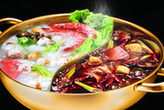 |
As northern China withers under freezing temperatures in the winter months, the country’s southern provinces, which enjoy a milder climate, retain many of the colors normally associated with the warmer seasons. And some of the most polychromatic scenery is to be found in the border province of Yunnan.
The subtropical region features marvelous red earth that is said to resemble the natural scenery around Rio de Janeiro in Brazil. Word among experienced travelers has it that the most spectacular red earth scenes are in Xintian Township of Dongchuan, a district northeast of downtown Kunming, the provincial capital. There, they say, the earth is “crushingly beautiful.”
The flamboyant red hue of the soil comes from embedded iron that has slowly undergone oxidation in the hot, humid climate. In Xintian, patches of “ruby land” intersperse fields of potato, buckwheat, rape, wheat and corn. These crops, planted in alternation, make for a collage of color, which becomes even more spectacular under the glow of sunrise or after a rain shower. Here, God is an artist and the land is His palette, one might say.
Having recently made a trip to Xintian, I now understand why visitors before me have fallen in love with the region.
Straight out of a Postcard My friends and I drove from Kunming along the expressway to Dali, a Bai ethnic minority autonomous prefecture. After a three-hour drive, we reached Hongtu (literally “Red Earth”) Town in Xintian.
Rural locales in China often possess rustic names, but Xintian is different. On our drive we passed many sites that must have been named by poets, including Rainbow Slope, the Gardens of Splendor, Rosy Cloud Ravine and the Pit of Music Scores.
Dongchuan District, in which Xintian is located, owes its fame to a photographer, who, during a flight over the area, spotted patterned splashes of red earth down below. Later he journeyed to Dongchuan to take photos, many of which went “viral” across the nation on publication. The once little known district became famous overnight.
November is not a time at which the natural wonder of Dongchuan is in full bloom, but the autumn landscape is still breathtaking. The month marks the last seeding season of the year. Strips of local land have been plowed in preparation, and a myriad of furrows run like crimson ribbons across the hilly terrain. Much of the land teems with diverse crops at different stages in the growing cycle – barley and wheat are only just pushing up through the earth, while rape and potato are in magnificent bloom.





Why not rent a boyfriend, or girlfriend to please parents during the Spring Festival?